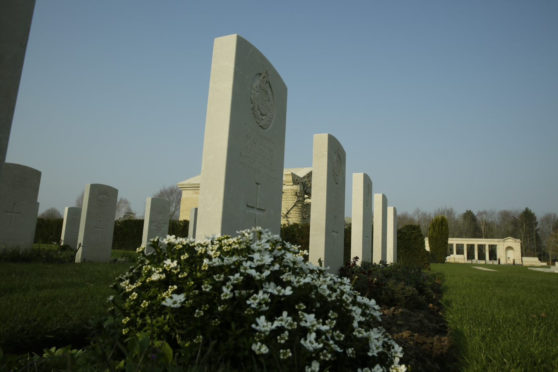
Senior politicians and veterans will attend a service of Remembrance at Bayeux War Cemetery – the Commonwealth War Graves Commission’s largest site of the Second World War in France.
The cemetery contains the graves of more than 4,100 Commonwealth servicemen along with 500 from other nations, including more than 460 German soldiers.
Opposite stands the Bayeux Memorial, bearing the names of more than 1,800 men and women of Commonwealth land forces who have no known grave.
They died during the Normandy landings, the intense fighting in the region and in the advance to the River Seine in August 1944.
During the Second World War, the Armed Forces were “far better prepared for dealing with their dead” than throughout the First World War, historian Max Dutton said.
Mr Dutton, assistant historian for the Commonwealth War Graves Commission (CWGC), told the Press Association: “Each unit had a burial officer.
“It was their responsibility to bury the dead, co-ordinate the burial of the dead and record where they had been buried.”
British artist Rex Whistler, who served in the Guards Armoured Division, was a burial officer but became the first of his battalion to die in the Normandy campaign.
The illustrator and designer was buried where he was killed in July 1944 before later being taken and laid to rest at the Banneville-La-Campagne War Cemetery.
Mr Dutton said: “Those who died were buried by their comrades. They used what they had, such as helmets, upturned rifles and crosses, to mark their graves.”
The locations of these graves were reported to Army Graves Registration Units (GRUs), with information later passed to Graves Concentration Units (GCUs).
After fighting had concluded, the bodies were exhumed and brought to the cemeteries.
Those laid to rest at Bayeux are from those battlefield burials and those who died in military hospitals around the town.
“There are only 1,800 missing soldiers because of the work of the burial officers, Graves Registration Units and Graves Concentration Units who went out to ensure that those who fell had a grave,” Mr Dutton said.
On the morning of D-Day, 500 men from 48 (Royal Marine) Commando came ashore on Juno Beach but more than half of them were injured, with 40 dead.
“The survivors had the task of returning to that beach and collecting the bodies of those who had died,” Mr Dutton said.
“They brought them to the garden of a nearby house and placed the much-respected green beret on the graves of their commandos.
“There would have been fighting near them as they did so.”
The commandos crafted crosses from wood taken from bombed-out houses nearby, with French villagers later placing flowers on the graves.
Those buried were exhumed and moved to Bayeux in December 1944 – a task carried out countless times throughout the war.
Almost all of those from 48 Commando who died on D-Day are buried together in Plot XIV, Rows A and B.
On June 11 in 1944, 30 men from No 32 GRU arrived in Normandy and set up an office in Bayeux where they began to work through reports from unit burial officers in the field.
The following month, on July 1, that unit taped out the outline of a cemetery in a field on the outskirts of the town, intending it to be used by nearby hospitals.
The first burials took place that month, with hundreds of graves dug by labour units and French citizens.
Only five plots were filled with those who died from wounds or illness in hospital, with most of the burials brought to the site by GCUs.
Space was allocated for the construction of shelter buildings, the Stone of Remembrance and the Cross of Sacrifice.
By the end of the war, some of those tending to the site included Normandy veterans.
“They had seen and had been there when the men in the cemetery died,” Mr Dutton said.
“A number of staff working in Normandy immediately after the war period stayed behind to look after their friends’ graves.
“The care that the staff in Normandy and across the world take of the war graves, for many of them it is more than a job – it is an honour and a privilege.”
Mr Dutton described the cemetery, visited by thousands of people each year, as a “remarkable place of pilgrimage and remembrance”.
This year at Bayeux, a memorial bench with audio triggered when visitors sit down will play recordings of veterans and the families of those killed in battle.
The sound installation, named Voices of Liberation, is also at Portsmouth Naval Memorial.

Enjoy the convenience of having The Sunday Post delivered as a digital ePaper straight to your smartphone, tablet or computer.
Subscribe for only £5.49 a month and enjoy all the benefits of the printed paper as a digital replica.
Subscribe